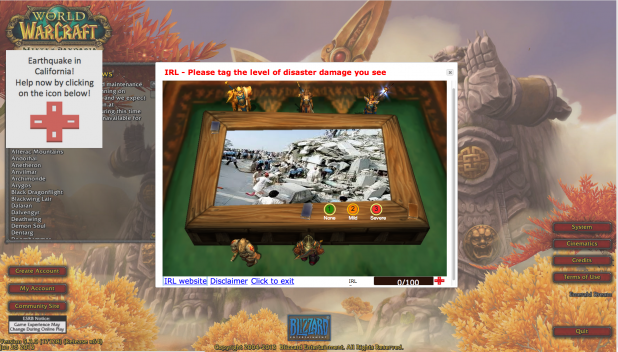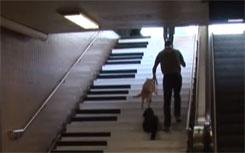[caption id="attachment_11566" align="aligncenter" width="618"]

A mockup of how the IRL plugin might look.[/caption] Three years ago, game designer and author Jane McGonigal argued that saving the human race is going to require a major time investment—in playing video games. “If we want to solve problems like hunger, poverty, climate change, global conflict, obesity, I believe that we need to aspire to play games online for at least 21 billion hours a week [up from 3 billion today], by the end of the next decade,” she said in a
TED talk. Games (particularly massively multiplayer online games), she explained, help people learn to solve problems and work in teams. The billions of hours spent on gaming represent a “virtually unprecedented human resource” that can be used to perform real-world work and become “a powerful platform for change.” Her message was not ignored—and it has indirectly contributed to the formation of something called the
Internet Response League (IRL). The small group has a big goal: to harness gamers’ time and use it to save lives after disasters, natural or otherwise.
Meeting of the Minds
A few months ago, humanitarian technology expert Patrick Meier was giving a talk at the Metropolitan College of New York. Meier, director of innovation at the Qatar Computing Research Institute and former co-director of Harvard University's Program on Crisis Mapping, described an idea that he’d had a few years previously but hadn’t yet implemented. The idea was to insert micro-tasks into games, specifically asking gamers to tag photos of disaster areas. In the minutes, hours, and days after disasters such as Hurricane Sandy or last year’s Typhoon Pablo in the Philippines, victims post massive numbers of photos to Twitter and other social networks. Unfortunately, the pictures aren’t as useful as they could be. Geo-tags and references to places could help relief groups identify locations. But actually sifting through all the photos to determine which ones show the most damage, a process that helps emergency responders target their efforts most effectively, takes a giant amount of man-hours—or gamer-hours. Referencing McGonigal’s talk, Meier suggested the gaming population would be ideal for this kind of task. The idea intrigued audience member Peter Mosur, an avid gamer and a graduate student studying emergency management, and he approached Meier immediately after the session. The two quickly got to work. They already have a beta version of a Web application, and hope to develop a plugin that could work with a broad range of games. The Web app is made in the style of
World of Warcraft, because that’s the game Meier and Mosur would really like start with. They have no confirmed partnerships with any game-makers yet, however.
Human Eyes Aren’t Obsolete
Despite advances in hardware and software, humans are still important for identifying damage in photos, Meier said. “At least for now, the photographs we get from disasters, it's best to have humans,” he said. “If you're talking about satellite imagery, that we can automate. But we're not talking about satellite imagery here.” With the IRL plugin, each image would be shown to at least three people, who tag the photo as showing no damage, mild damage, or severe damage. “And only if these three different individuals tag that picture as showing severe damage, do we say ‘ok we are trusting the consensus here that this picture does show severe damage, let's ship that picture out to the American Red Cross now,’” Meier said. The strategy itself isn’t new. After Typhoon Pablo last December, Meier and his colleagues collected 13,000 relevant tweets (identified by the hashtag) and paid people from a crowdsourcing platform called
Crowdflower to evaluate them. “The database of processed tweets was then shared (every couple hours) with the Standby Volunteer Task Force (SBTF). SBTF volunteers (‘Mapsters’) only focused on tweets that had been geo-tagged and tagged as relevant (e.g., ‘Casaualties,’ ‘Infrastructure Damage,’ ‘Needs/Asks,’ etc.) by Crowdflower workers,” Meier wrote in a
blog post. It cost just $250 to process the 13,000 tweets, but they were only able to evaluate an average of 750 tweets in an hour. Meier thinks he can do better.
World of Warcraft players raised $2.3 million for relief efforts after Hurricane Sandy, so they are generous people, he reasons. “If they're willing to donate five dollars and 10 dollars we're saying fantastic, by all means do that,” he said. “What you can also do is donate five minutes of your time, and that will be as important because what you're doing with your time donation is you’re tagging crisis information that humanitarian organizations like the American Red Cross are going to use to gain better situational awareness with respect to the disaster, and allow them to operationally respond far quicker than they would otherwise be able to.” Even if gamers tagged just one or a few images each, that could add up to millions very quickly. The Internet Response League has been in talks with a couple of indie developers, including one that’s developing a new MMO. Mosur said they’ve tried to get in touch with
World of Warcraft maker Blizzard, but haven’t had any luck yet. Blizzard did not return a request for comment from Slashdot.
Making Crowdsourcing Native to the Game Environment
Mosur, a longtime fan of
World of Warcraft as well as a newer multiplayer game, League of Legends, said PC-based MMOs are the best environment for the IRL plugin both in terms of the technology and engaged user base. Ideally, game developers would work with the IRL to make the plugin seem like a part of the game and not intrusive. “Let's say you're in
World of Warcraft and you're in a major city wasting some time, checking auctions, and an alert pops up, ‘Hey there was an earthquake somewhere in the world and we need your help,’” Mosur said. “You click a button and it transports your character into another area with a specially set up design for tagging.” As described on the Internet Response League’s Website, “the moment that a disaster strikes, everyone currently playing the game and those logging on from that point on will receive notification of the event. Only users who have opted in to receive these ‘alerts’ will see them. The message will give a brief description of what has happened, and will ask players to help out with the tagging.” Although the IRL hasn’t yet found a game company to embed the plugin into an MMO, Meier said the Web application could be put into action today if necessary. The process of uploading tweets into the system can be easily automated, he said. “If the disaster hit tomorrow, we'd be able to use it,” he said. “The user interface is not perfect because we're not expert graphic designers. But we’re getting feedback from a colleague of mine. It may not look pretty but it’s already there.” The IRL plugin will initially support Instagram photos, and other social networks later on.
Gamers Aren't Evil, and They Might Want to Help
One critical question: will gamers want to take time out from exploring the game world to help out in the real world? McGonigal thinks they will if engaged on their own terms, telling
New Scientist in a
recent article: “If we want to engage hundreds of millions of gamers in real-world problem-solving, we need to learn how to do it inside existing games, not outside of them. That's why the Internet Response League is such an impressive project.” Games and gamers often get a bad rap, blamed by politicians for violent crimes even when there’s no evidence of a connection between games and violent acts. Research attempting to link games and violence has come up with mixed results at best—there’s just as much reason to think games can contribute to positive behavior. Games have likely saved lives already. Just last month, a 10-year-old boy from Colorado steered his great-grandmother’s car to safety after she suffered a heart attack at the wheel, and he credited
Mario Kart for teaching him how to drive. Researchers including North Carolina State University’s
Gains Through Gaming lab are studying the ways in which gaming can improve cognitive functioning. Brainpower is important for leading raids and winning battles, but Mosur is confident that a large population of
World of Warcraft-type gamers will be interested in helping out with disaster recovery as well. “There's definitely going to be a crowd of people who will say that it’s a distraction, that it takes away from the core experience,” he said. “But I think there's a crowd that feels the opposite way, that you're playing a game to relax, with something like this you’re still relaxing but you're also helping out.” It requires a change in the way games are played, though, and gaining acceptance from the gaming community will be more difficult than rolling out the technology, Meier said. “It's not a technical challenge. That’s the thing: It's actually quite easy,” he said. “It's more about raising awareness and making the case to gaming companies and to gamers that this is something new, innovative, and worth. It's really a behavior challenge rather than a technical challenge."
Image: IRL  A mockup of how the IRL plugin might look.[/caption] Three years ago, game designer and author Jane McGonigal argued that saving the human race is going to require a major time investment—in playing video games. “If we want to solve problems like hunger, poverty, climate change, global conflict, obesity, I believe that we need to aspire to play games online for at least 21 billion hours a week [up from 3 billion today], by the end of the next decade,” she said in a TED talk. Games (particularly massively multiplayer online games), she explained, help people learn to solve problems and work in teams. The billions of hours spent on gaming represent a “virtually unprecedented human resource” that can be used to perform real-world work and become “a powerful platform for change.” Her message was not ignored—and it has indirectly contributed to the formation of something called the Internet Response League (IRL). The small group has a big goal: to harness gamers’ time and use it to save lives after disasters, natural or otherwise.
A mockup of how the IRL plugin might look.[/caption] Three years ago, game designer and author Jane McGonigal argued that saving the human race is going to require a major time investment—in playing video games. “If we want to solve problems like hunger, poverty, climate change, global conflict, obesity, I believe that we need to aspire to play games online for at least 21 billion hours a week [up from 3 billion today], by the end of the next decade,” she said in a TED talk. Games (particularly massively multiplayer online games), she explained, help people learn to solve problems and work in teams. The billions of hours spent on gaming represent a “virtually unprecedented human resource” that can be used to perform real-world work and become “a powerful platform for change.” Her message was not ignored—and it has indirectly contributed to the formation of something called the Internet Response League (IRL). The small group has a big goal: to harness gamers’ time and use it to save lives after disasters, natural or otherwise.
 A mockup of how the IRL plugin might look.[/caption] Three years ago, game designer and author Jane McGonigal argued that saving the human race is going to require a major time investment—in playing video games. “If we want to solve problems like hunger, poverty, climate change, global conflict, obesity, I believe that we need to aspire to play games online for at least 21 billion hours a week [up from 3 billion today], by the end of the next decade,” she said in a TED talk. Games (particularly massively multiplayer online games), she explained, help people learn to solve problems and work in teams. The billions of hours spent on gaming represent a “virtually unprecedented human resource” that can be used to perform real-world work and become “a powerful platform for change.” Her message was not ignored—and it has indirectly contributed to the formation of something called the Internet Response League (IRL). The small group has a big goal: to harness gamers’ time and use it to save lives after disasters, natural or otherwise.
A mockup of how the IRL plugin might look.[/caption] Three years ago, game designer and author Jane McGonigal argued that saving the human race is going to require a major time investment—in playing video games. “If we want to solve problems like hunger, poverty, climate change, global conflict, obesity, I believe that we need to aspire to play games online for at least 21 billion hours a week [up from 3 billion today], by the end of the next decade,” she said in a TED talk. Games (particularly massively multiplayer online games), she explained, help people learn to solve problems and work in teams. The billions of hours spent on gaming represent a “virtually unprecedented human resource” that can be used to perform real-world work and become “a powerful platform for change.” Her message was not ignored—and it has indirectly contributed to the formation of something called the Internet Response League (IRL). The small group has a big goal: to harness gamers’ time and use it to save lives after disasters, natural or otherwise.
 A mockup of how the IRL plugin might look.[/caption] Three years ago, game designer and author Jane McGonigal argued that saving the human race is going to require a major time investment—in playing video games. “If we want to solve problems like hunger, poverty, climate change, global conflict, obesity, I believe that we need to aspire to play games online for at least 21 billion hours a week [up from 3 billion today], by the end of the next decade,” she said in a TED talk. Games (particularly massively multiplayer online games), she explained, help people learn to solve problems and work in teams. The billions of hours spent on gaming represent a “virtually unprecedented human resource” that can be used to perform real-world work and become “a powerful platform for change.” Her message was not ignored—and it has indirectly contributed to the formation of something called the Internet Response League (IRL). The small group has a big goal: to harness gamers’ time and use it to save lives after disasters, natural or otherwise.
A mockup of how the IRL plugin might look.[/caption] Three years ago, game designer and author Jane McGonigal argued that saving the human race is going to require a major time investment—in playing video games. “If we want to solve problems like hunger, poverty, climate change, global conflict, obesity, I believe that we need to aspire to play games online for at least 21 billion hours a week [up from 3 billion today], by the end of the next decade,” she said in a TED talk. Games (particularly massively multiplayer online games), she explained, help people learn to solve problems and work in teams. The billions of hours spent on gaming represent a “virtually unprecedented human resource” that can be used to perform real-world work and become “a powerful platform for change.” Her message was not ignored—and it has indirectly contributed to the formation of something called the Internet Response League (IRL). The small group has a big goal: to harness gamers’ time and use it to save lives after disasters, natural or otherwise.

